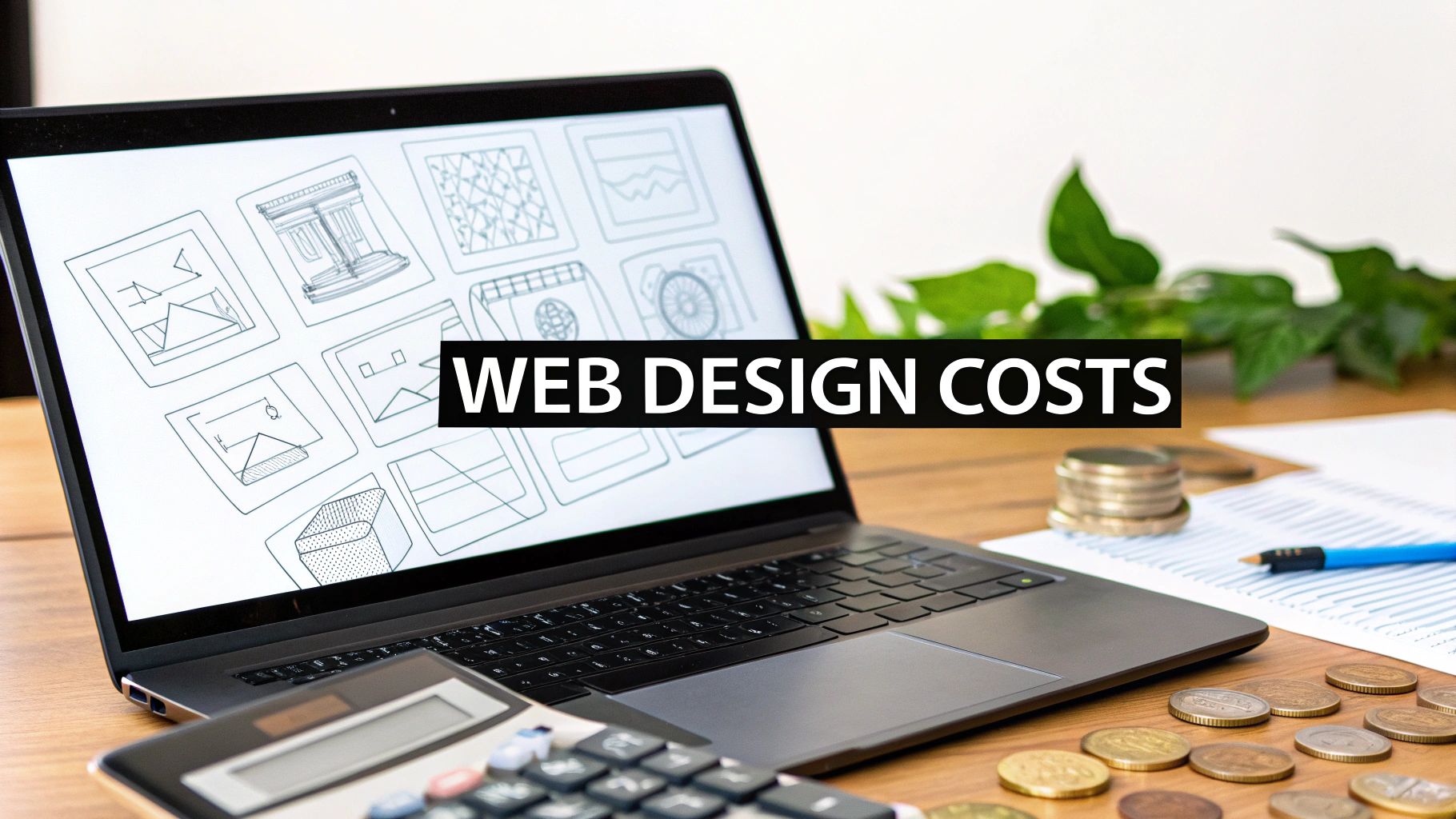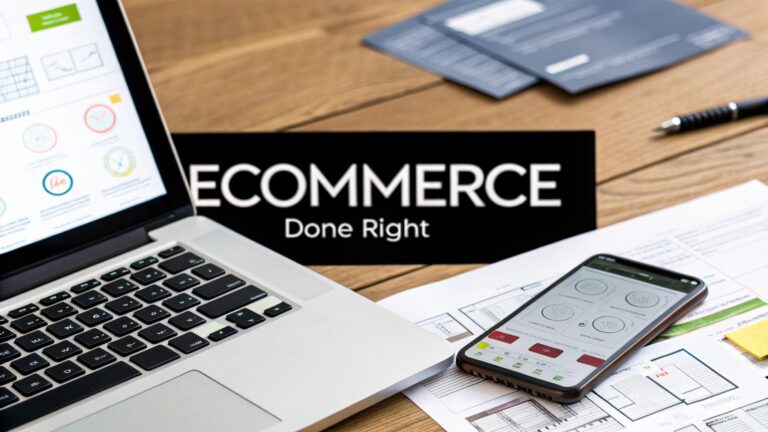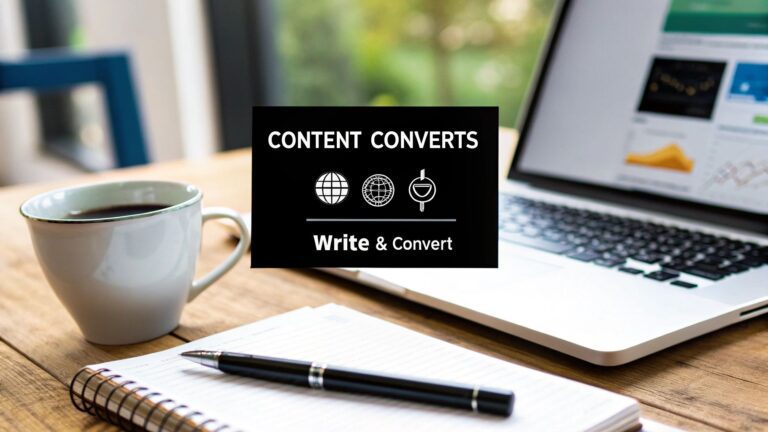When someone asks, "How much does a website cost?" it's a bit like asking, "How much for a car?" Are we talking about a reliable runaround or a high-performance sports car? The final price tag depends entirely on what's under the bonnet. In the UK, a simple, effective website can start from as little as £500, but a sophisticated e-commerce platform with all the bells and whistles can easily climb past £15,000.
The real key is understanding what your investment gets you at each stage of the journey.
UK Website Design Costs at a Glance
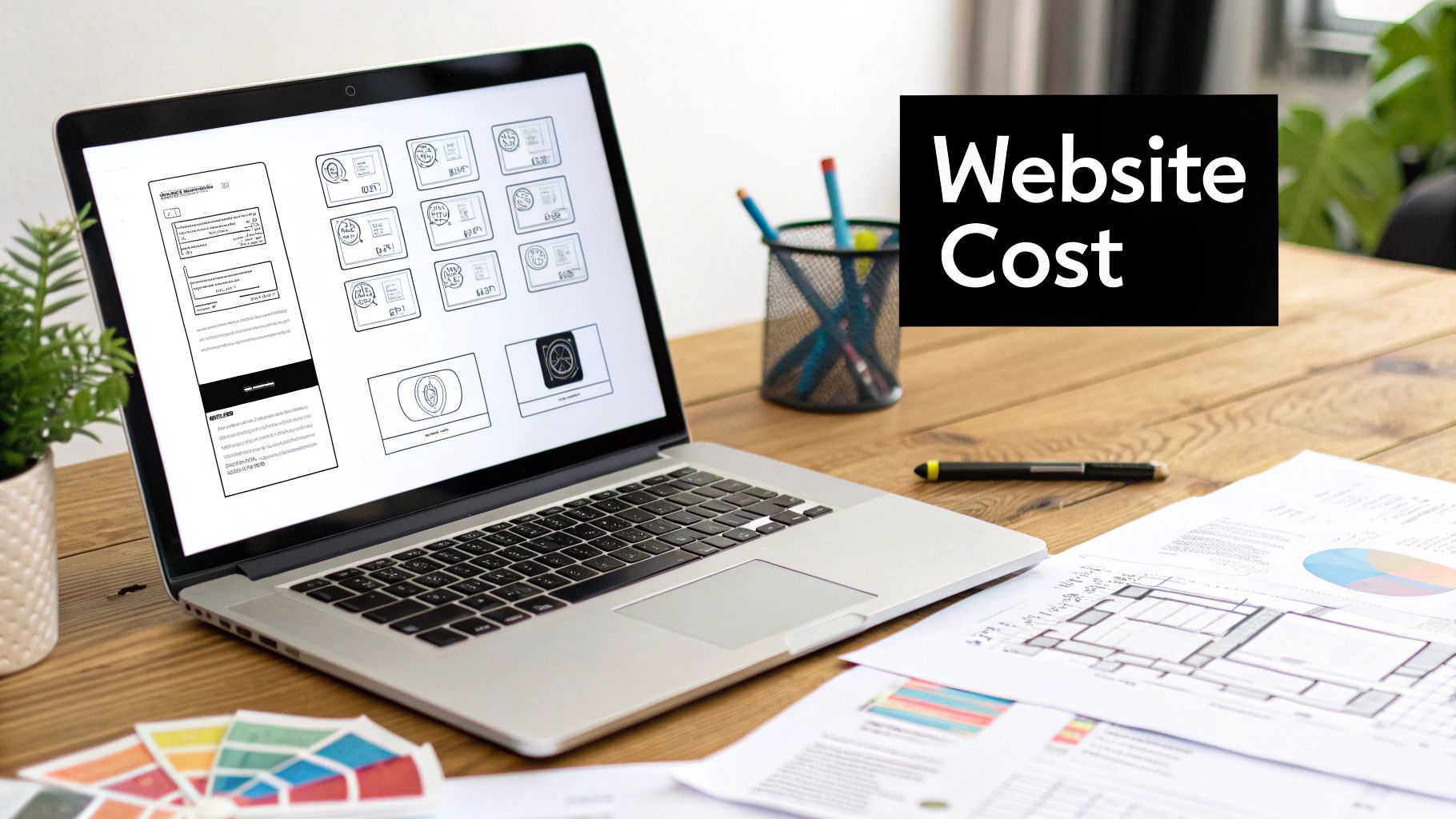
It helps to think about UK website design costs in three main tiers. Each one is built for a different kind of business, from a new startup that just needs to get its name out there to an established company looking to build a powerful online sales machine. Working out which bracket you fall into is the first, most crucial step to creating a sensible budget.
The Three Tiers of Web Design Pricing
For 2025, the pricing landscape is fairly clear and breaks down based on how complex and functional you need your site to be.
- The budget tier, usually between £500 and £1,500, is the perfect starting point for new businesses or sole traders who need a professional, clean, template-based site to act as their digital business card.
- Next, the mid-range tier sits between £1,500 and £5,000. This is the sweet spot for growing businesses that need something more distinctive, perhaps with a content management system (CMS) and some custom features.
- Finally, the premium tier kicks off at £5,000 and can go well beyond £15,000. This is for fully bespoke projects that demand unique designs and advanced systems.
It’s also worth noting that if you're based in London, you should probably budget for about 20-30% more to cover the higher agency costs in the capital.
These prices aren't just pulled out of thin air. They directly reflect the amount of time, skill, and strategic thinking that goes into your project. A budget site is quick and efficient, often using a pre-built template. A premium site, on the other hand, involves deep-dive strategy sessions, custom code, and a user experience crafted from the ground up just for your audience.
Key Takeaway: Your initial investment is directly tied to the level of customisation and functionality you'll receive. A larger budget opens the door to truly bespoke design, advanced features, and a much more strategic approach to development.
What to Expect in Each Price Bracket
To give you a clearer picture, here’s a quick summary table that breaks down what you can typically expect for your money at each level.
UK Website Design Costs at a Glance
| Tier | Typical Cost Range (£) | Best For | Key Features |
|---|---|---|---|
| Budget | £500 – £1,500 | New Startups & Sole Traders | Template-based design, 5-10 pages, basic contact form, mobile responsive. |
| Mid-Range | £1,500 – £5,000 | Growing SMEs | Semi-custom design, CMS integration, blog functionality, basic e-commerce. |
| Premium | £5,000 – £15,000+ | Established Businesses | Fully bespoke UX/UI, advanced e-commerce, custom integrations (CRM, booking systems). |
Understanding these tiers helps you match your expectations to your budget from day one. It means you can have much more productive conversations with potential web designers and make decisions you feel confident about.
If you’re ready for a deeper dive into what drives these prices, have a look at our guide on https://www.ibertechsolutions.co.uk/unlocking-the-mystery-of-website-building-costs-a-comprehensive-guide-for-smes. It’ll give you all the background you need to plan your project.
What Really Drives Your Website's Price Tag?
Looking at the general price brackets is a great starting point, but to really get a grip on your budget, you need to understand the individual parts that can make the total cost creep up or down. It’s a bit like choosing a new car—you have the base model price, but adding things like leather seats, a panoramic sunroof, or a beefier engine will naturally change the final figure. The same logic applies to the cost of designing a website.
These are the core levers that web designers and agencies pull when they put together your quote. Once you understand them, you can have much clearer conversations about your project and decide where to put your money for the best possible return.
This infographic breaks down the main cost drivers into three key areas.
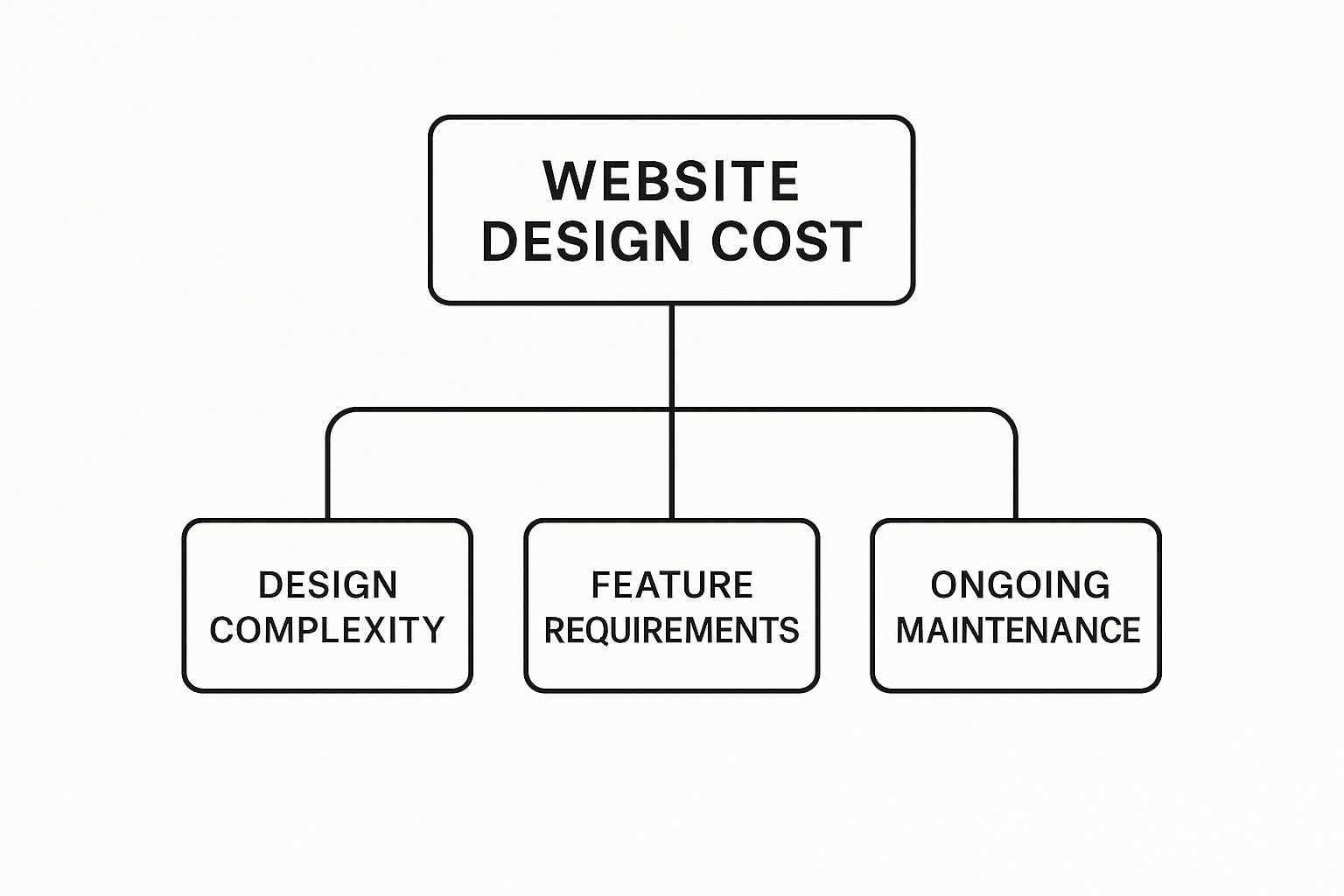
As you can see, the final price tag is a mix of the design's complexity, the specific functions you need, and the ongoing support required to keep it running smoothly.
Design and UI/UX Complexity
This is usually the single biggest factor affecting your bill. The core question is: are you happy with a clean, professional site built from a top-notch template, or do you need a completely original, one-of-a-kind design built from the ground up?
- Template-Based Design: This is the most budget-friendly path. A designer takes a pre-built theme and tailors it with your brand’s colours, fonts, and logo. It’s a much faster process and demands less design time, making it perfect for smaller budgets.
- Custom (Bespoke) Design: This involves creating a unique user interface (UI) and user experience (UX) from scratch, designed specifically for your audience and business goals. The process involves wireframing, mockups, and intensive design work, which adds a significant amount to the cost.
A bespoke design offers total creative control and a unique digital footprint, but don't underestimate templates. A well-chosen and expertly customised template can still deliver a fantastic result for a fraction of the price.
Total Number of Pages
An easy way to think about this is like building a house—every extra room adds to the overall cost. A simple five-page 'brochure' website (Home, About, Services, Blog, Contact) will always be far cheaper than a 50-page corporate site with detailed service pages, case studies, and individual team member profiles.
Each page needs its own design considerations, content, and optimisation, all of which add to the project's timeline and complexity. Before you even ask for a quote, it’s a great idea to map out a rough sitemap of the absolute essential pages you need to launch.
E-Commerce Functionality
If you want to sell products directly from your site, you’re stepping into a completely different league of website development. Adding e-commerce is a major cost driver simply because it introduces a huge amount of technical complexity.
Setting up an online shop is so much more than just adding a 'Buy Now' button. It involves secure payment gateway integration, product catalogue management, inventory systems, customer accounts, and a rock-solid, secure checkout process.
Your choice of platform (like Shopify or WooCommerce for WordPress) and the sheer number of products you intend to sell will also influence the price. For a deeper dive, check out our guide on 7 e-commerce website design tips you need to know to help you plan your online store effectively.
Specialised Features and Integrations
Beyond the standard pages and e-commerce, any custom functionality you require will add to the budget. These kinds of features demand specialist development hours and often mean plugging into third-party systems.
Common examples we see are:
- Booking and reservation systems for service providers, salons, or restaurants.
- Membership portals with gated content for paying subscribers.
- Advanced contact forms with conditional logic that changes based on user input.
- Integration with a CRM (Customer Relationship Management) system like HubSpot or Salesforce.
Each one of these features is like a mini-project within the main website build, requiring its own careful planning, development, and testing.
Content Creation and SEO
Finally, don't forget the actual words and pictures that bring the pages to life. Some businesses come to the table with their own professional copy and photography, but many rely on their agency to handle this. Professional copywriting, brand photography, and creating content that's optimised for search engines (SEO) are all specialist services with their own price tags.
Investing in high-quality content and foundational SEO from day one is absolutely vital for your site's long-term success. It’s what ensures that once the site is live, your target audience can actually find it. This upfront investment pays for itself many times over in visibility and traffic down the line.
Real-World Website Cost Scenarios for UK Businesses
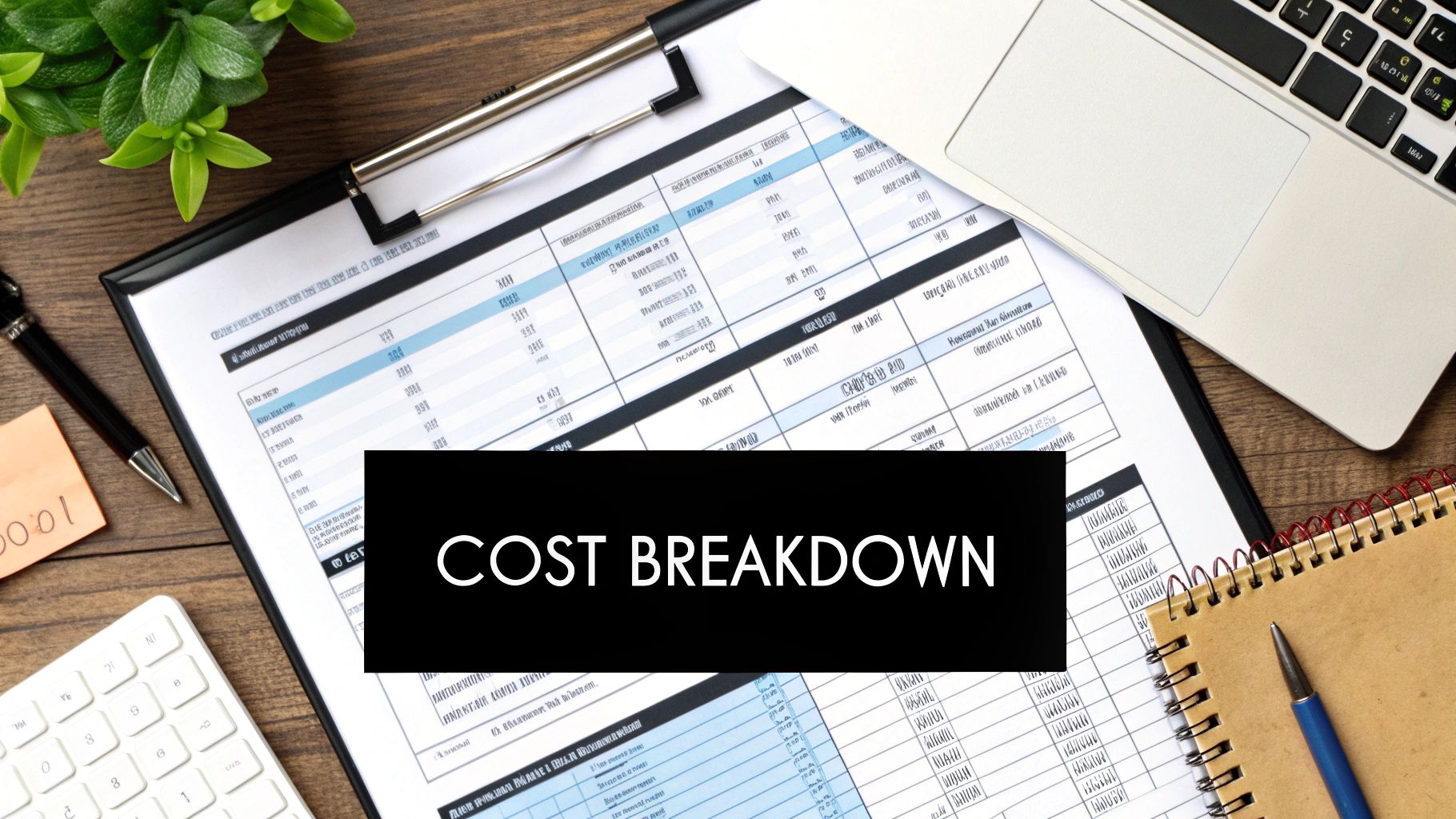
Talking about abstract price brackets is one thing, but it’s much more helpful to see how these numbers play out in the real world. Let's be honest, the final cost of a website comes down to the value and functionality it needs to deliver for your specific business.
To make this crystal clear, we'll walk through three common scenarios for UK businesses. Each example breaks down how specific goals and features directly influence the final investment, giving you a solid benchmark for your own project.
Scenario 1: The Local Tradesperson's Brochure Site
First up, imagine a self-employed electrician in Norfolk. Their goal is straightforward: get a professional-looking site online where potential customers can find their contact details, see a list of services, and read a few testimonials. They’re not selling products; they’re selling trust and expertise.
For this kind of business, a clean, simple "brochure" website is perfect. Think of it as a digital business card that’s working for you 24/7.
Key Features and Cost Breakdown:
- Design: A professionally customised, premium template. This is a smart move that keeps design costs down while still looking modern and working perfectly on mobile.
- Pages: Around 5-7 core pages are all that's needed: Home, About, Services, Testimonials, a small Gallery, and a Contact page.
- Functionality: It just needs the basics—a simple contact form and a phone number that’s clickable on mobile devices.
- Content: The electrician provides their own text and photos of completed jobs.
A project like this is all about the essentials. The focus is purely on building credibility and generating local leads, without getting bogged down in complex digital systems.
For a UK small business, a foundational website like this is an incredibly powerful asset. Industry data for 2025 shows that website design costs often land between £800 and £5,000, depending on what's involved. A basic brochure site fits squarely in the £800 to £2,000 range, which is exactly what our electrician needs.
Scenario 2: The Growing E-commerce Business
Now, let's picture a small Suffolk-based business that sells handmade candles. They've built a loyal following at local markets and are now ready to sell their products across the UK. This is a big step up in functionality compared to our electrician.
This business needs a proper e-commerce platform that can handle everything from beautiful product displays to secure online payments.
Project Scope and Investment:
- Platform: A robust platform like Shopify or a WordPress site powered by the WooCommerce plugin is essential for managing online sales.
- Design: A semi-custom design is needed to create a unique brand feel that helps them stand out from the crowd.
- Functionality: This is where the work is. It needs secure payment gateway integration (like Stripe or PayPal), a product catalogue for 20-50 items, inventory tracking, and the ability for customers to create accounts.
- SEO: Basic on-page SEO is crucial from day one to help their candles show up in search results.
The investment here is quite a bit higher because of all the technical heavy lifting. A well-built e-commerce site for a small but growing business typically falls into the £2,000 to £5,000 price bracket. For new ventures looking to manage that initial outlay, exploring options like startup grants can be a savvy way to fund essential growth tools like a new website.
Scenario 3: The Service-Based Business with Custom Needs
Finally, let's consider a business consultant who offers bespoke training packages. They want a members-only area where their clients can access exclusive content. This website isn't just a marketing tool; it's a core part of how they deliver their services.
This kind of project demands custom development to create a seamless experience that’s deeply integrated with their day-to-day operations.
Features Driving the Cost:
- Custom Functionality: The centrepiece is a secure membership portal, complete with tiered access levels for different client groups.
- Integration: It needs to connect to a CRM system for managing client relationships and an online booking system for scheduling consultations.
- Content: It will feature a blog for sharing expertise and a private resource library packed with materials for paying members.
This level of customisation pushes the project firmly into the premium category. Websites with complex requirements like CRM integration or membership portals often start from £5,000 and can easily go beyond £20,000, depending on the exact specifications. That price reflects the intensive development time required to build, test, and launch these interconnected systems successfully.
Budgeting for Hidden and Ongoing Website Expenses
One of the most common pitfalls I see business owners fall into is thinking that the cost to design a website is a one-off payment. It's an easy mistake to make. Launching your site feels like crossing the finish line, but in reality, you've just started the race. To keep your new digital asset working for you, you have to budget for its upkeep.
Forgetting about these ongoing costs is like buying a brand new car and not setting aside any money for petrol, insurance, or its annual MOT. It might look fantastic sitting on your drive, but it’s not going to get you anywhere. These aren't sneaky "hidden fees" cooked up by developers; they're the predictable and essential investments required to protect your website and ensure it performs well for years to come.
Factoring these costs in from day one is just smart financial planning. It helps you build a realistic long-term strategy and avoid nasty surprises, which is especially important if you're looking for funding. When you're calculating your total project cost, don't forget to consider how things like business loan interest rates will affect your overall budget.
Essential Recurring Costs
First, let's cover the absolute must-haves. Think of these as your website's utility bills – you have to pay them to keep the lights on and the doors open online.
- Domain Name Renewal (£10 – £20 per year): This is the small but vital annual fee you pay to keep your website address (like
yourbusiness.co.uk). Don't let this expire! - Web Hosting (£100 – £500+ per year): You're essentially renting space on a server for your website to live. The price tag changes depending on your hosting provider, the quality of the server, and how much traffic you get. Cheap hosting is tempting, but slow load times and poor performance will lose you customers.
- SSL Certificate (£0 – £70 per year): This is what puts the little padlock icon in the browser's address bar, encrypting data and telling visitors your site is secure. Many hosts bundle a free SSL certificate these days, but more advanced certificates come with an annual fee. It’s an absolute deal-breaker for user trust and security.
These core costs are the bare minimum. But just keeping the lights on isn’t a strategy for growth.
An unmaintained website is a security risk and a poor investment. You wouldn't leave your physical shop unlocked overnight, so why would you leave your digital storefront vulnerable to threats or simple neglect?
Strategic Ongoing Investments
Beyond the basics, a few other ongoing investments are crucial if you want your website to grow your business. These are the things that turn a static online brochure into a dynamic tool that generates leads and sales.
Website Maintenance Plans (£30 – £200+ per month)
If you ask me, this is the single most important ongoing expense. A good maintenance plan isn't just a "nice-to-have"; it’s your insurance policy. It usually covers:
- Regular software and plugin updates to patch security holes.
- Daily or weekly backups of your entire site (files and database).
- Security scans to find and get rid of malware.
- Uptime monitoring that alerts you the second your site goes down.
Honestly, skipping maintenance is the number one reason websites get hacked. The monthly cost of a plan is a tiny fraction of what you'd pay for an emergency cleanup, not to mention the damage a security breach can do to your reputation.
Content and SEO (£300 – £2,000+ per month)
A website isn't a "set it and forget it" project. If you want to attract new customers, you need to give Google a reason to send them your way. That means investing in ongoing content creation and search engine optimisation (SEO). This could involve writing blog posts, refreshing your service pages, and building your site's authority so you climb up the search rankings.
Periodic Redesigns (Every 3-5 Years)
The web moves fast. A design that looks fresh and modern today can feel clunky and dated in just a few years. It's wise to plan for a significant refresh or even a full redesign every three to five years. This keeps your user experience sharp, aligns the site with your evolving business goals, and ensures your initial investment continues to deliver a return.
Choosing Your Web Design Partner

Deciding who will actually build your website is one of the biggest calls you'll make. It directly impacts the final cost to design a website and, just as importantly, its quality. You’re not just looking for someone who can write code; you're looking for a partner whose skills, approach, and price point click with what your business needs.
Think of it like getting a new kitchen. You could get a flat-pack kit and tackle it yourself (DIY), hire a trusted local joiner (a freelancer), or bring in a design-and-build firm with a whole crew (an agency). Each route can give you a brilliant result, but they come with very different price tags, time commitments, and levels of hands-on expertise.
Let's break down your three main options.
Hiring a Freelance Web Designer
A freelance web designer is a one-person-band, offering a direct, personal service. The big advantage here is that you deal with the same person from start to finish. This makes communication much simpler and helps build a strong working relationship where they really get your vision.
Financially, freelancers are almost always more affordable than agencies because they don't have the same overheads. This makes them a fantastic option for start-ups and small businesses who need a professional, custom-built site but are working with a tighter budget.
The trade-off? A freelancer is still just one person. Their schedule might be packed, potentially leading to longer project timelines. And while many are jacks-of-all-trades, their core expertise might be in design but not necessarily in SEO or copywriting.
Partnering with a Web Design Agency
A web design agency brings a full team of specialists to the table. We’re talking project managers, UI/UX designers, developers, writers, and SEO experts, all under one roof. This collective brainpower means every part of your website is handled by a dedicated professional, resulting in a strategically sound and highly polished final product.
Agencies are set up to handle complexity, like large e-commerce shops or websites needing custom software integrations. They follow structured processes, provide robust ongoing support, and have the manpower to deliver big projects faster. Of course, this comprehensive, all-in-one service comes with a higher price tag that reflects the team's combined skill and the agency's running costs.
The choice between a freelancer and an agency often boils down to the scale and complexity of your project. An agency provides a complete, end-to-end solution, while a freelancer offers a more personal and cost-effective service for smaller, more focused websites.
Using a DIY Website Builder
DIY platforms like Squarespace, Wix, and WordPress.com have opened up web design to everyone. They use intuitive drag-and-drop editors, allowing you to build a perfectly functional website with zero coding knowledge. This is, without a doubt, the cheapest route, with your main outlay being a low monthly subscription fee.
This path gives you total control, but it demands a serious investment of your own time. You become the designer, the writer, the developer, and the troubleshooter. While these platforms are surprisingly powerful, they do have their limits and can't replicate the truly unique, bespoke solutions a professional can create. For those looking at design-first tools, Framer's platform also offers a compelling alternative to traditional build services.
For many small businesses, a DIY site is a brilliant starting point. If you're a small business owner heading down this path, our guide on how to design a website for a small business breaks down the entire process.
Comparison of Web Design Options
Ultimately, the partner you choose is a critical cost driver. In the UK, professional website design costs can range from £500 to over £15,000, depending heavily on whether you hire a freelancer, an agency, or do it yourself. And with 50% of consumers admitting that a company’s website design shapes their impression of the business, it's vital to get this decision right.
To help you weigh everything up, the table below gives you a clear, side-by-side look at your options.
| Factor | Freelancer | Agency | DIY Builder |
|---|---|---|---|
| Typical Cost | £1,500 – £5,000 | £5,000 – £15,000+ | £20 – £100/month |
| Best For | Start-ups & SMEs | Growing & Established Businesses | Solopreneurs & Micro-businesses |
| Key Pro | Personal touch & lower cost | Comprehensive expertise & support | Low cost & full control |
| Key Con | Limited availability & skillset | Higher cost & less personal | Time-consuming & functional limits |
Each path has its own merits. The best choice is the one that aligns with your budget, your timeline, and your long-term ambitions for your business online.
Your Website Cost Questions, Answered
Starting a new website project naturally brings up a lot of questions. It's completely normal to want a clear picture before you dive in. Here, we’ll tackle some of the most common queries we hear about the cost to design a website, giving you the straightforward answers you need to plan your next steps with confidence.
How Long Does It Really Take to Build a Website?
This is the classic "how long is a piece of string?" question. The honest answer is: it all comes down to the size and complexity of what you need built.
A straightforward brochure-style website, perhaps using a pre-existing template as a starting point, can be up and running surprisingly quickly. We're talking as little as two to four weeks from start to finish.
On the other hand, if you're looking at something more bespoke, like a custom e-commerce shop with hundreds of products or a specialised membership portal, you'll need to think on a longer timescale. These larger projects have multiple stages—deep planning, design mock-ups, development, and thorough testing. For a build like this, you should realistically set aside three to six months, and sometimes even longer, from the first chat to the final launch.
Key Insight: The project timeline and the final cost are two sides of the same coin. A quick build for a simple site means fewer hours to bill for. A longer, more involved project reflects the huge amount of specialist time required to get it right.
What Information Should I Prepare Before Asking for a Quote?
Want the secret to getting a truly accurate quote? It’s simple: come prepared. The more detail you can give a designer or agency upfront, the better they can grasp your vision and price the work involved. A vague brief will always lead to a vague (and often wrong) quote.
To get the ball rolling, try to pull these things together before your first meeting:
- Your Main Goal: What's the number one thing this website must do for your business? Is it generating phone calls, selling products directly, or capturing email leads?
- A Basic Sitemap: Just a simple list of the pages you think you’ll need is a great start. Think Home, About Us, Services, Blog, and Contact.
- Website Examples You Like: Find a few sites you admire and be ready to point out exactly what you like. Is it the clean layout, the colour palette, or how easy it is to navigate?
- Your Content Plan: Do you have your text and images ready to go? Or will you need help writing copy and sourcing professional photography?
- A Rough Budget: It helps enormously if you have a realistic budget range in mind. This allows a designer to suggest a solution that actually works for you financially.
How Much Should I Budget for Monthly Website Maintenance?
Thinking about ongoing maintenance isn't just a good idea—it's essential for protecting your investment. See it as the routine upkeep for your digital storefront. It keeps everything secure, fast, and working as it should. Skipping it is a false economy that almost always ends in a costly emergency down the line.
For a small to medium-sized UK business, a typical maintenance plan will run you somewhere between £30 and £200 per month. The price difference depends entirely on the level of service and support you need.
So, what do you get for that? A good plan should always include:
- Regular Updates: Keeping your core system (like WordPress), theme, and plugins updated is the first line of defence against security holes.
- Secure Backups: Your site's files and database should be backed up daily or weekly, so it can be restored in a flash if the worst happens.
- Security Monitoring: Actively scanning for malware, suspicious activity, and attempted hacks.
- Performance Checks: Making sure your site stays quick and responsive for all your visitors.
Trust us, investing in a solid maintenance plan is far, far cheaper than an emergency clean-up after your site gets hacked. That kind of crisis can cost thousands and do real damage to your reputation. It's a running cost you should absolutely factor in from day one.
Ready to get a clear, accurate quote for your project? The team at Ibertech Solutions Limited provides bespoke web design for businesses across Norfolk and Suffolk, with transparent pricing and no hidden fees. Contact us today for a no-obligation consultation and let's build a website that delivers real results.


